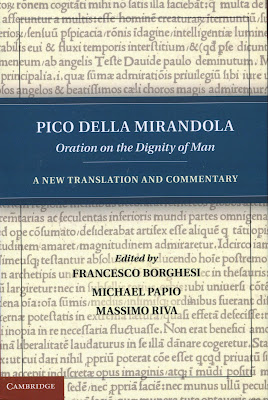One of the advantages of random or undisciplined reading is the occasional unexpected juxtaposition.
I had mentioned in a previous post my recently begun reading of Pico della Mirandola; the new volume is pictured above. I had also, earlier in the year, ordered a version of Hugo's Notre Dame de Paris, admittedly because it appeared to be a rather interestingly designed and illustrated version. I had read it in English back in the '80's, and thought it might not be too formidable to re-read in French.
I don't know how Notre Dame de Paris came to be translated as The Hunchback of Notre Dame. Quasimodo is undeniably a major character, but Esmeralda is in some ways more central to the plot. In any case, there's some critical consensus that the cathedral itself should be considered the real protagonist, the novel more a painting of Hugo's richly imagined sense of the Gothic than a conventional story.
What happened to catch my attention was the realization of the relatively late setting of Hugo's evocation of the medieval. The novel, with its full complement of hungry poets, lustful clerical alchemists, wonder-working gypsies, riotous students, fraudulent beggars, popinjay soldiers and other picturesque grotesques, begins on January 6, 1482.
And this puts us in the full flower of the quattrocento. In 1482 our friend Giovanni Pico is studying philosophy, Greek and rhetoric at Pavia and seeking a copy of Marsilio Ficino's Theologia Platonica. The next year he enters the circle around Lorenzo de' Medici in Florence, and in 1485 we find him in Paris, spending a season at the Sorbonne.
Pico was of course an atypical Parisian student, a wealthy aristocrat. His "type" is largely absent from Hugo's tragedy. Nor do I want to concede to Hugo's late fifteenth century Paris greater historical accuracy than it merits. Hugo was a pioneer in the nineteenth century's new interest in the medieval, and though his story and characteristic digressions were based on considerable research, I very much doubt that his picture of Pico's Paris would pass muster by contemporary historical standards.
Nevertheless, the juxtaposition of the polymath humanist with the grotesque splendors of Hugo's Gothic vision remains a bit jarring. By 1486 Pico is preparing for his great disputation in Rome to reconcile Christian and pagan, Plato and Aristotle, Chaldean, Moslem and cabalist. But his sojourn in Paris--roughly contemporaneous with Hugo's final, melancholy scene from the Montfaucon--can help remind us of the fragility of the oft-exaggerated distinction between the late medieval and the Renaissance.



No comments:
Post a Comment